
Our shop is situated on wooded land in rural Maine. There’s lots of wildlife to enjoy, but some not so enjoyable including the occasional feral dog, rabid fox and two legged skunk that wanders in from out of state. Self reliance is key and carrying makes a lot of sense.
I don’t like hauling around full size revolvers or autoloaders as they tend to get in the way of normal activities, subsequently I found myself searching for a good small gun for this application. Not a tiny gun I can hide in my belt buckle or hang on a keychain, but some middle ground between full size and ultra compact handguns.
What size would that be…
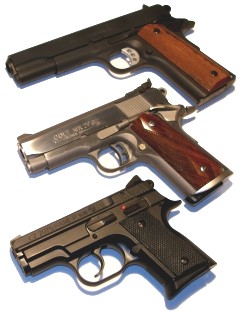
Pictured right for context, from top to bottom, full size 1911 Government, Officer’s Model 1911 and the CZ 2075 RAMI. These are all guns I shoot with some frequency and enjoy, however, the RAMI is the only one in the bunch that fits the criteria of a useful small gun. The Officer’s Model almost makes the category, but I tinkered with it until it outgrew the perfect size with accessory sights and extended Smith & Alexander magazine guide. In addition, it is made of stainless steel and quite heavy.
| Indices | Gov’t | Officers | RAMI |
| Weight* | 38 | 32 | 24 |
| Length | 8.5″ | 7.5″ | 6.5″ |
| Height | 5.25″ | 5.25″ | **4.25″ |
| Frame Width | 0.75″ | 0.75″ | 1.01 |
| Grip Width | 1.33″ | 1.280 | 1.280 |
| * Actual weight – digital scale ** 5.00″ with extended magazine |
|||
In a few hundred words, why I chose the CZ 2075…
The RAMI is just like a real gun, only smaller. A mature model, a 2004 introduction, it is available in both 9mm Luger and 40 S&W. I dismissed the 40 S&W as a round for the indecisive. It doesn’t have the punch of a 10mm or 45 ACP, and it doesn’t have the good shooting manners or capacity of the 9mm Luger. Yes, I know I’ve publically admitted to owing a 40 S&W Glock but that’s only because ambivalence is an integral part of Glock ownership. In recap, I tolerate the 40 S&W, but it isn’t my first choice for…anything and specifically not for this size gun. I also excluded the 380 ACP, 32 ACP or 25 ACP as needlessly underpowered. I wasn’t looking for a last resort back up gun. I wanted a gun with a cartridge that would do more than mildly irritate the recipient of its bullet. Accordingly, I went with the 9mm Luger. Why does Hogan’s Heroes and Sergeant Shultz come to mind when I think of the word “Luuuger”?
 For general applications, the CZ 2075 comes in two versions, alloy and the “P” model poly frame. One of the primary differences between the alloy and poly versions, besides the obvious, has been that the “P” version has a lighter scalloped sided slide and is “P” stamped for identification. I bought a new CZ 2075 alloy frame gun, with all matching numbers; barrel, frame and slide that came with the “P” designation. I spoke with Jason Morton at CZ-USA and he explained that the factory is transitioning to a common slide, the “P” type. Until the supply of “P” stamped slides is consumed, all models will have the “P” slide designation. My gun weighs 24 ounces with a 10 round magazine, the poly frame gun is listed as 23.5 ounces. This suggests I didn’t need to buy a poly gun to get light weight. Another nice benefit of the alloy version is removable grips. The poly grips are integral to the poly frame…and the name of a product for denture wearers.
For general applications, the CZ 2075 comes in two versions, alloy and the “P” model poly frame. One of the primary differences between the alloy and poly versions, besides the obvious, has been that the “P” version has a lighter scalloped sided slide and is “P” stamped for identification. I bought a new CZ 2075 alloy frame gun, with all matching numbers; barrel, frame and slide that came with the “P” designation. I spoke with Jason Morton at CZ-USA and he explained that the factory is transitioning to a common slide, the “P” type. Until the supply of “P” stamped slides is consumed, all models will have the “P” slide designation. My gun weighs 24 ounces with a 10 round magazine, the poly frame gun is listed as 23.5 ounces. This suggests I didn’t need to buy a poly gun to get light weight. Another nice benefit of the alloy version is removable grips. The poly grips are integral to the poly frame…and the name of a product for denture wearers.
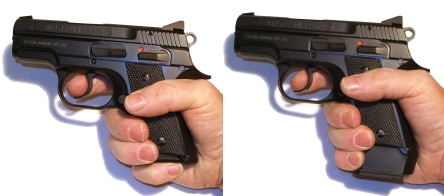 The RAMI 9mm has a 10 round capacity in standard trim, 14 with a high capacity magazine. My gun was received with two high capacity magazines. Since compact size was a primary consideration at the onset of the project, I ordered additional standard magazines. As I write this paragraph, the jury is still out on preference. The extended grip does offer a nice place to park my pinky, but the short grip may be enough for good control of the 9mm. The extended grip does provide for 4 more rounds, but then I shoot better than either Nicolas Cage or John Travolta in “Face Off”, so I might not need them. Decisions, decisions, decisions. Procrastination, procrastination, procrastination.
The RAMI 9mm has a 10 round capacity in standard trim, 14 with a high capacity magazine. My gun was received with two high capacity magazines. Since compact size was a primary consideration at the onset of the project, I ordered additional standard magazines. As I write this paragraph, the jury is still out on preference. The extended grip does offer a nice place to park my pinky, but the short grip may be enough for good control of the 9mm. The extended grip does provide for 4 more rounds, but then I shoot better than either Nicolas Cage or John Travolta in “Face Off”, so I might not need them. Decisions, decisions, decisions. Procrastination, procrastination, procrastination.
But will it hold up in heavy use?
 The CZ 2075 is double-single action and utilizes a typical CZ cam locking system. However, unlike larger CZ models, the RAMI does not have multiple radial locking lugs on the barrel. The RAMI utilizes the barrel’s stout top rectangular surface to provide lockup. The system is very similar to my P 229 SIG that routinely ingests hot 357 SIG loads. The lockup on the 2075 is probably less prone to wear and tear deterioration than the radial lug set up.
The CZ 2075 is double-single action and utilizes a typical CZ cam locking system. However, unlike larger CZ models, the RAMI does not have multiple radial locking lugs on the barrel. The RAMI utilizes the barrel’s stout top rectangular surface to provide lockup. The system is very similar to my P 229 SIG that routinely ingests hot 357 SIG loads. The lockup on the 2075 is probably less prone to wear and tear deterioration than the radial lug set up.
The CZ 2075 has a firing pin block and no decocker. It can be carried with a round in the chamber with the hammer back and the safety on, aka “cocked and locked” or the hammer can be carefully lowered over a loaded round. At that point, the firing pin safety will prevent the firing pin from contacting the loaded cartridge unless the trigger is fully depressed in double action mode. Yes, the notion of lowering a hammer on a loaded round does bump my heart rate up a beat or two, but it is actually a lot easier than it sounds as long as the hammer lower…er is paying attention and doing so in a safe circumstance. There is of course the option of carrying the gun with an empty chamber.
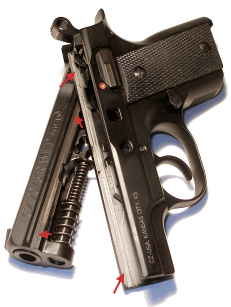 Like its bigger brother, the SP-01, the CZ 2075 has rails inside the frame rather than outside like a 1911 or a Glock. The result is a very long bearing surface that accurately and consistently maintains the relationship of slide, barrel and frame and makes for a strong assembly.
Like its bigger brother, the SP-01, the CZ 2075 has rails inside the frame rather than outside like a 1911 or a Glock. The result is a very long bearing surface that accurately and consistently maintains the relationship of slide, barrel and frame and makes for a strong assembly.
The double action trigger pull is aerobic at 11 lbs, single action is acceptably light at 5 lbs. The trigger motion of the CZ 2075, is like a little amusement park ride for the trigger finger. There is the first 0.200″ of free travel where there is only light resistance and compression of the firing pin stop spring occurs. Then there is the 0.100″ ride over the sear until the hammer is released. In double action mode there is an additional 0.300″ of ground to cover in the initial stage as the hammer is cocked. For as much as my brain cells suggest anything more than a 1911’s feather weight pull and hair line sear engagement is excessive, the ease of shooting this gun accurately makes the CZ’s trigger only different, not functionally deficient.
The cartridge case gets a lot of support, the feed ramp intrudes minimally, and the chamber walls are very heavy. I don’t see the RAMI as a gun that would blow +P cases. I experienced no problem with handloads throughout the project and some of them were pretty warm.
Handloading considerations and strategy…

The 9mm Luger, left, in the event you’ve been out of town since 1902, is a straight wall case with 13.8 grains of water capacity. By comparison, the 38 Super holds 17.5 grains and the 380 ACP 12.3 grains. Others may argue, particularly to those who send me email written in crayon, that the 380 ACP could be a better choice since it is so close to the 9mm Luger in capacity. Good thought, however, the more substantial difference between the 380 ACP and 9mm Luger is operating pressure. The 380 ACP has a maximum average pressure of 19,580 PSI. The 9mm Luger is listed as 34,084 PSI CIP, 35,000 SAAMI and 38,500 in SAAMI +P form. The low pressure limits the 380 ACP bullet to the sub 100 grain range with a more typical 95 grains at approximately 1,000 fps. The 9mm Luger can push the same weight bullet 350 fps faster and a 147 grain bullet to the 1000 fps mark. Due to the small case capacity, both cartridges are pretty much at home in short barrel guns, so the 9mm Luger does not really add the problem of less complete powder burn than the 380 ACP.
It’s tough to assess a handgun load. In all of my years of hunting and recreational shooting, I have never seen a living thing explode like a bullet struck water jug, or have its innards turned into hydrostatically shocked jelly or fly through the air upon bullet impact. I have seen a bucket full of sand sit passively in its original spot on a table after being repeatedly struck by a 375 H&H at close range…the bullet not the rifle. I have seen some game die quicker than others, mostly when massive damage has been done to vital organs by a well expanded bullet ahead of a large wound channel. With less than 10 grains of net case capacity and a 3″ barrel, I knew exceptional kinetic energy and high velocity would not be primary considerations, so the observations would be of velocity, but also penetration, expansion and bullet weight retention. I specifically omitted frangible bullets and any bullets referred to as “explosive” in terminal ballistics. I am not a police officer who needs to follow departmental policy or a resident within an area of dense population. I am also not looking to turn targets into jelled hamburger. What I am essentially looking for is a bullet that will expand at 3″ barrel producing velocity to a large diameter and retain most, if not all, of its original weight.
And in this corner…
I thought I would start by selecting some reasonable bullet weights, of reasonable construction for anticipated velocities, then rely on terminal ballistic test data to determine what worked best. I didn’t try to do a one for one comparison of bullet types across all weight groups. I felt if any one was a stand out I would do further investigation. No, I don’t know exactly what that all means, but you’ll be the first to know when I figure it out, and I will figure it out…eventually.
| Lightweight Contenders | ||||
 |
||||
| Bullet | Mfg # | grains | Length | Diameter |
| Nosler JHP | 44848 | 115 | 0.5165″ | 0.3455″ |
| Sierra JHP | 8110 | 115 | 0.5038″ | 0.3550″ |
| Speer JHP | 3994 | 115 | 0.5317″ | 0.3553″ |
| Winchester JHP | WB9JHP115 | 115 | 0.5374″ | 0.3547″ |
| Bullets listed left to right as pictured | ||||
| Middleweight Contenders | ||||
 |
||||
| Bullet | Mfg # | grains | Length | Diameter |
| Hornady JHP | 35571 | 124 | 0.5730 | 0.3550″ |
| Remington JHP* | 23934 | 124 | 0.5758″ | 0.3547″ |
| Remington JHP | 23557 | 124 | 0.5633″ | 0.3456″ |
| Sierra JHP | 8125 | 125 | 0.5451″ | 0.3456″ |
| Bullets listed left to right as pictured * Golden Saber – Brass jacket – driving band diameter |
||||
|
Heavyweight Contenders |
||||
 |
||||
| Bullet | Mfg # | grains | Length | Diameter |
| Hornady JHP | 35580 | 147 | 0.6554″ | 0.3544″ |
| Remington JHP | 23538 | 147 | *0.7230″ | 0.3548″ |
| Speer JHP | 4002 | 147 | 0.6600″ | 0.3552″ |
| Bullets listed left to right as pictured *J bullet – includes dimpled base projection |
||||
Powder 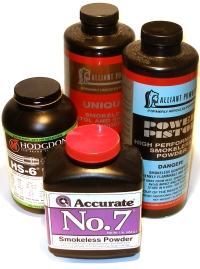
Powders selected were mainstream for the 9mm Luger and readily available. Speed was toward the moderate range in burn rate. I apologize for some of the older labels. My relatively large inventory of powder doesn’t seem to notice the buying and selling and repackaging of companies. Most smokeless powder is non-hygroscopic, which means it is doesn’t absorb moisture from the atmosphere, so a little temp control and protection from UV means it will outlast most of us.
Alliant Unique is a relatively fast burning powder that matches up well to the 9mm Luger’s capacity and bullet weights. It ignites easily, but leaves a bit more than the typical residue.
Alliant Powder Pistol, was actually developed by Hercules for the government in the mid 70’s specifically for the 9mm Luger round and has been extensively used over the years by Remington and Winchester for commercial 9mm Luger loading. It is a bit slower than Unique, a bit smaller in grain size. It meters well and burns cleanly. Used in small, high pressure cases it typically delivers higher velocity at comparatively moderate pressure levels. I use this powder for lots of loads, particularly for the 357 SIG.
Accurate Arms No. 7 was selected predominately for the heavier bullet weight range. AA 7 works well at high pressures, particularly the 9mm Luger. Lighter loads, or loads in lesser pressure cartridges tends to lead to incomplete burn and wide spreads in shot to shot velocity.
Hodgdon HS-6 began life as a shotgun powder with large grains to keep it out of open primer cups. It works well for the 9mm Luger with the exception of not being a very clean burning powder. It is on the slow side in burn rate and probably more useful with heavier bullet weight.
Primer type selected was CCI 500, small pistol standard powder.
Handloading
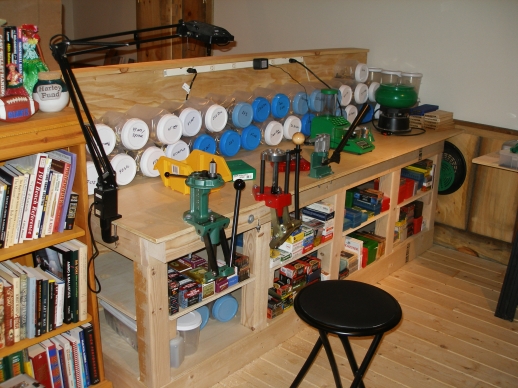
This is the first project from the new shop. Consequently, things are still being moved around and organized and painted or trimmed. My wife came up with the three quart Dollar Store jugs to hold brass along the top of the bench and that proved to be a nice organizing improvement. At least a couple of presses are down for work. I dropped my RCBS APS priming press off the bench when I was marking drill holes and broke the body casting of at the feed track. I thought that was $115 worth of damage but a call to RCBS with an honest explanation of what happened yielded free replacement parts. They always do that and that is one of the reasons they are a good equipment supplier.
The preliminary loads were assembled on an RCBS Turret Press, then production was assembled on a Lee Classic Turret. I used the RCBS unit specifically because of the wider die spacing that made die adjustment and changes easier. I used the Lee Classic Turret for production because it is easy to control in progressive mode and requires less motion. I used an APS bench tool for priming because I am very old and set in my ways and the press and primer strips are a clean reliable way to prime. Because of frequent changes in powder types and charges, I relied on ChargeMaster 1500 Digital Scale. I have to admit this model scale is head and shoulder above its predecessor in reaching stable weight and repeatability of readings. Not cheap in price, but worth every penny.
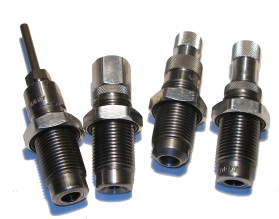
Dies utilized were Lee Deluxe Pistol, a four die set. With a carbide insert sizer, no lube is required and the factory crimp die is invaluable when working with smaller autoloader cartridges. The 9mm Luger of course headspaces on the case mouth and case tension after sizing is more than enough to retain a bullet, but the factory crimp die also serves as an assembled round sizing die; a last check to make sure the round will make chamber spec and feed properly. With some of the thicker Remington brass I was loading, as well as with some of the compressed loads, this last step really made for reliable operation. Fired cases measured 0.388″ at the mouth compared to a 0.380″ spec. The Lee die sizes cases to 0.377″ to mid case prior to a run through the expander.
 The only anomalies in the routine of establishing COL were the Hornady 124 grain and Sierra 125 grain bullets. With a 0.300″ shanks and blunt angular ogives, any cartridge assembled with these bullets to a length greater than 1.045″ would not consistently fully chamber. The picture, left, illustrates the various ogive contours for, top to bottom, the Hornady 124, the Sierra 125 and the Winchester 115. Sierra’s manual recommends a 1.075″ COL, Hornady 1.060″. The 1.045″ dimension was arrived at by dye coating sample bullets and attempting to close the breech, then seating deeper, until the gun locked up cleanly. The 1.045″ allows lock up and provides a margin of clearance for reliability.
The only anomalies in the routine of establishing COL were the Hornady 124 grain and Sierra 125 grain bullets. With a 0.300″ shanks and blunt angular ogives, any cartridge assembled with these bullets to a length greater than 1.045″ would not consistently fully chamber. The picture, left, illustrates the various ogive contours for, top to bottom, the Hornady 124, the Sierra 125 and the Winchester 115. Sierra’s manual recommends a 1.075″ COL, Hornady 1.060″. The 1.045″ dimension was arrived at by dye coating sample bullets and attempting to close the breech, then seating deeper, until the gun locked up cleanly. The 1.045″ allows lock up and provides a margin of clearance for reliability.
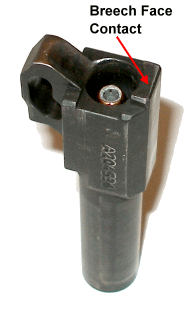 Assembled to 1.045″, the bullet diameter is still 0.355″ at a distance 0.855″ from the case head. The SAAMI chamber spec establishes a diameter of 0.354″ at 0.811″ forward of the breech face, where a taper begins to form the shallow taper of the rifling leade, before the rifling closed down to the 0.346″ bore diameter.
Assembled to 1.045″, the bullet diameter is still 0.355″ at a distance 0.855″ from the case head. The SAAMI chamber spec establishes a diameter of 0.354″ at 0.811″ forward of the breech face, where a taper begins to form the shallow taper of the rifling leade, before the rifling closed down to the 0.346″ bore diameter.
In the absence of a pin gauge 0.355″ in diameter, I figured I could get a down and dirty chamber length measurement by flipping a bullet over, dropping it into the chamber, then measuring the distance from the face of the barrel breech face lug to the nose of the bullet inverted in the chamber. The depth from lug to bullet was 0.324″, the bullet 0.545″ for a total of 0.859″ which left a minimum of 0.004″ between the bullet nose and any trace of smaller barrel diameter.
Does this matter? In every circumstance where there was greater net case capacity, higher velocity was attainable, but with no greater pressure, as a result of pressure persistence from the increase in powder. That’s my theory and I’m sticking with it.
Little lost to barrel length…
One of the nice things about smaller capacity cases operating at higher pressures is that they tend to not be overly barrel length sensitive and some of the powders theoretically came close to 99% burn. In the powder descriptions noted earlier, some powders had a reputation for not burning cleanly. They are powders that have the lowest completion of burn in the short barrel because of slower relative burn rate. I would hazard a guess, and guessing can sometimes be hazardous, that the same powders are the ones often described as having a good deal of muzzle flash as powder continues to burn for a distance beyond a gun’s muzzle. I have a short barrel 44 mag that looks like a flame thrower at dusk. Ever the optimist, I figure the first shot illuminates the target, the second shot is for score.
Luger handload data is publish based on a 4″ barrel, but the 3″ barrel gave up little in velocity with optimized loads at +P pressure levels as would typically be the case with large handgun cartridges. Initially, I thought I would have to do a lot of bullet juggling to meet a particular bullet manufacturer’s design impact velocity for proper expansion, but this proved not to be the case…meeting the velocity criteria that is, which did not always lead to anticipated expansion.
| 9mm Luger | Weight Grains |
Length Inch |
Net Cap H20 |
COL Inch |
AA7 | Ft/sec | HS6 | Ft/sec | Pwr Pstl | Ft/sec | Unique | Ft/sec |
| Nosler | 115 | 0.5165 | 11.1 | 1.100 | 8.7 | 1068 | 7.1 | 1092 | 6.9 | 1207 | 5.7 | 1119 |
| 9.0 | 1109 | 7.4 | 1101 | 7.2 | 1237 | 6.0 | 1163 | |||||
| Sierra | 115 | 0.5038 | 8.5 | 1.065 | 8.4 | 1076 | 6.6 | 1012 | 6.4 | 1191 | 5.4 | 1118 |
| 8.7 | 1131 | 6.9 | 1047 | 6.7 | 1208 | 5.7 | 1162 | |||||
| Speer | 115 | 0.5317 | 9.0 | 1.125 | 9.1 | 1093 | 7.2 | 1102 | 7.0 | 1257 | 5.8 | 1136 |
| 9.4 | 1147 | 7.5 | 1150 | 7.3 | 1260 | 6.1 | 1159 | |||||
| Winchester | 115 | 0.5374 | 9.3 | 1.130 | 8.8 | 1050 | 7.1 | 1037 | 6.9 | 1217 | 5.7 | 1138 |
| 9.1 | 1096 | 7.4 | 1083 | 7.2 | 1236 | 6.0 | 1169 | |||||
| Hornady | 124 | 0.5730 | 6.2 | 1.045 | 6.5 | 996 | 5.2 | 975 | 5.1 | 1230 | 4.2 | 1091 |
| 6.8 | 1055 | 5.5 | 1044 | 5.4 | 1242 | 4.5 | 1098 | |||||
| Rem GS | 124 | 0.5758 | 9.0 | 1.162 | 8.7 | 1036 | 6.9 | 1098 | 6.7 | 1143 | 5.6 | 1054 |
| 9.0 | 1083 | 7.2 | 1145 | 7.0 | 1219 | 5.9 | 1081 | |||||
| Rem JHP | 124 | 0.5633 | 8.6 | 1.130 | 8.4 | 1041 | 6.6 | 1004 | 6.5 | 1167 | 5.4 | 1066 |
| 8.7 | 1078 | 6.9 | 1082 | 6.8 | 1199 | 5.7 | 1075 | |||||
| Sierra | 125 | 0.5451 | 7.0 | 1.045 | 7.2 | 980 | 5.7 | 975 | 5.6 | 1189 | 4.6 | 1122 |
| 7.5 | 1024 | 6.0 | 1035 | 5.9 | 1196 | 4.9 | 1162 | |||||
| Hornady | 147 | 0.6554 | 6.0 | 1.110 | 6.2 | 985 | 4.9 | 803 | 4.8 | 1007 | 4.0 | 983 |
| 6.4 | 1022 | 5.1 | 910 | 5.1 | 1053 | 4.2 | 1022 | |||||
| Remington | 147 | 0.7230 | 5.5 | 1.130 | 5.8 | 781 | 4.6 | 754 | 4.6 | 865 | 3.8 | 853 |
| 6.0 | 869 | 4.8 | 798 | 4.8 | 958 | 4.0 | 926 | |||||
| Speer | 147 | 0.6540 | 6.6 | 1.130 | 6.9 | 919 | 5.4 | 751 | 5.3 | 1013 | 4.4 | 920 |
| 7.2 | 970 | 5.7 | 852 | 5.6 | 1079 | 4.7 | 1024 |
There is more to life than bullet specs and chronographs…

| # | Manufacturer | Weight Grains |
MV fps |
Retained Weight |
Expanded Diameter “ |
Penetration “ |
| 1 | Nosler | 115 | 1237 | 114.9 | 0.370 | 12 |
| 2 | Sierra | 115 | 1191 | 114.8 | 0.460 | 12 |
| 3 | Speer | 115 | 1260 | 110.9 | 0.480 | 10 |
| 4 | Winchester | 115 | 1236 | 114.0 | 0.636 | 6 |
| 5 | Rem GS | 124 | 1219 | 121.4 | 0.602 | 6 |
| 6 | Hornady | 124 | 1098 | 120.1 | 0.501 | 7 |
| 7 | Rem JHP | 124 | 1199 | 123.1 | 0.562 | 12 |
| 8 | Sierra | 125 | 1035 | 125.0 | 0.635 | 5 |
| 9 | Rem JHP | 147 | 958 | 147.0 | 0.355 | 10 |
| 10 | Hornady | 147 | 985 | 147.0 | 0.356 | 14 |
| 11 | Speer | 147 | 1013 | 147.0 | 0.356 | 11 |
| 12 | Factory UMC | 124 | 1006 | 115 | 0.357 | 8 |
| Impact 10′ from muzzle | ||||||
The full details of each bullet’s impact performance and expansion, as well as test methods applied, are covered in “Building a $2 Bullet Analyzer“. I believe, however, the picture and table above do a good job of summarizing results. My three favorite bullets for self defense, in order of preference, based on not over penetrating and on most complete expansion are: Remington 124 grain BJHP Golden Saber, Winchester 115 grain Notched JHP and Sierra 125 grain JHP. The Golden Saber was by far the best performer in handloading flexibility, accuracy, expansion, etc.

The Remington Golden Saber 124 grain, with its driving band design, subjects only the driving band to obturation while the remainder of the body primarily rides on the lands. The reduction in bearing surface and bore friction makes higher velocity levels obtainable at safe pressures, or same velocity at lower pressure.
Small gun, big gun accuracy
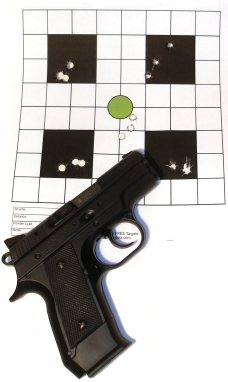
The picture left represents typical group size within handloads and factory ammunition. The shooting distance was seven yards, which is about all that is of interest to me for this application, and shot from a two hand hold so my chronograph would not be my first victim.
The top right target 1.6″ group was shot first, Remington UMC 124 grain target loads. After I warmed up a bit I went back and shot the 0.4″ group bottom right with the same ammo. Top left is a 124 grain Golden Saber group, 0.5″. Bottom left, 0.7″ was shot with Hornady 147 grain, center 0.8″ group with 124 grain Speer Gold Dots. The RAMI would have permitted better however, I’m not that good and the weather was wet and freezing. It’s hard to shoot straight and bounce around to keep warm.
When I finished up all of the handloading and check out activities, I spent some shooting the RAMI for enjoyment. The CZ 2075 is a well behaved small gun that packs a punch. I found I could shoot as well with the standard or extended grip, finding my pinky curled up under the mag made for as stable a hold as the provided by the extended mag shape. Recoil is light, report is mild and, even after hundreds of rounds, I didn’t feel smacked around.
The sights are three dot type and are green luminescent; not tritium, however, they take a charge from other light sources and will glow in the dark for some indeterminate period of time. As a professional whiner, I would like to see larger dots and real tritium sights that are easy to locate in a low light situation, however, if seven yards is really the operational range, the gun is too easy to point and shoot to be concerned about missing. Both front and rear sights are dovetail mounted and drift adjustable. The rear sight has a locking set screw, the front sight it punch set.
Conclusion
Quality gun, great price. Cindy, at the Real Gun shop sells them for a couple bucks over $500, in a plastic hard case with two mags, cleaning kit and mag loader. The RAMI isn’t a clunker Taurus or Bersa, nor is it an overpriced Beretta or SIG, nor is it a cheap plastic striker type. The materials, machine work, casting, stampings and assembly work are top notch. The gun feels solid and it is ergonomically shaped to be stable in almost any hand. If I were to pick nits and spend some time on refinement, I’d look for ways of reducing single action trigger pull and making it a bit more crisp while not reducing reliability. I might look around for a set of tritium sights with slightly larger dot, only because my eyesight is at the “shoot by Braille” stage. The gun needs grips, not for shape or comfort, just for style. If I get some time I may make a set of Box Elder Burl with a smooth flat rubbed finish. Yup, classy little gun, good cartridge.
Thanks,
Joe

Email Notification